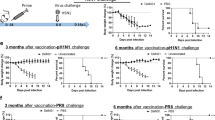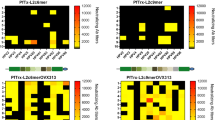Abstract
Intradermal vaccination via gene gun efficiently delivers DNA vaccines into dendritic cells (DCs) of the skin, resulting in the activation and priming of antigen-specific T cells in vivo. In the context of DNA vaccines, we previously used the gene gun approach to test several intracellular targeting strategies that are able to route a model antigen, such as the human papillomavirus type-16 (HPV-16) E7, to desired subcellular compartments in order to enhance antigen processing and presentation to T cells. These strategies include the use of the sorting signal of lysosome-associated membrane protein (LAMP-1), Mycobacterium tuberculosis heat-shock protein 70 (HSP70), calreticulin (CRT) and the translocation domain (dII) of Pseudomonas aeruginosa exotoxin A (ETA). Vaccination with DNA vaccines encoding E7 antigen linked to any of these molecules all led to a significant enhancement of E7-specific CD8+ T-cell immune responses and strong antitumor effects against an E7-expressing tumor, TC-1. However, we were interested in identifying the most potent DNA vaccine for our future clinical trials. Thus, we performed a series of experiments to directly compare the potency of the various DNA vaccines. Among the DNA vaccines we tested, we found that vaccination with pcDNA3-CRT/E7 generated the highest number of E7-specific CD8+ T cells and potent long-term protection and treatment effects against E7-expressing tumors in mice. Interestingly, we observed that pcDNA3-CRT/E7 is also capable of protecting against an E7-expressing tumor with downregulated MHC class I expression, a common feature associated with most HPV-associated cervical cancers. Our data suggest that the DNA vaccine linking CRT to E7 (CRT/E7) may be a suitable candidate for human trials for the control of HPV infections and HPV-associated lesions.
This is a preview of subscription content, access via your institution
Access options
Subscribe to this journal
Receive 12 print issues and online access
$259.00 per year
only $21.58 per issue
Buy this article
- Purchase on Springer Link
- Instant access to full article PDF
Prices may be subject to local taxes which are calculated during checkout






Similar content being viewed by others
References
Donnelly JJ, Ulmer JB, Shiver JW, Liu MA . DNA vaccines. Annu Rev Immunol 1997; 15: 617–648.
Pardoll DM, Beckerleg AM . Exposing the immunology of naked DNA vaccines. Immunity 1995; 3: 165–169.
Robinson HL, Torres CA . DNA vaccines. Semin Immunol 1997; 9: 271–283.
Condon C et al. DNA-based immunization by in vivo transfection of dendritic cells. Nat Med 1996; 2: 1122–1128.
Porgador A et al. Predominant role for directly transfected dendritic cells in antigen presentation to CD8+ T cells after gene gun immunization. J Exp Med 1998; 188: 1075–1082.
Cheng WF et al. Tumor-specific immunity and antiangiogenesis generated by a DNA vaccine encoding calreticulin linked to a tumor antigen. J Clin Invest 2001; 108: 669–678.
Chen CH et al. Enhancement of DNA vaccine potency by linkage of antigen gene to an HSP70 gene. Cancer Res 2000; 60: 1035–1042.
Hung CF et al. Cancer immunotherapy using a DNA vaccine encoding the translocation domain of a bacterial toxin linked to a tumor antigen. Cancer Res 2001; 61: 3698–3703.
Ji H et al. Targeting human papillomavirus type 16 E7 to the endosomal/lysosomal compartment enhances the antitumor immunity of DNA vaccines against murine human papillomavirus type 16 E7-expressing tumors. Hum Gene Ther 1999; 10: 2727–2740.
Sato Y et al. Immunostimulatory DNA sequences necessary for effective intradermal gene immunization. Science 1996; 273: 352–354.
Munger K et al. Complex formation of human papillomavirus E7 proteins with the retinoblastoma tumor suppressor gene product. EMBO J 1989; 8: 4099–4105.
Cheng WF et al. CD8+ T cells, NK cells and IFN-gamma are important for control of tumor with downregulated MHC class I expression by DNA vaccination. Gene Therapy 2003; 10: 1311–1320.
Restifo NP et al. Identification of human cancers deficient in antigen processing. J Exp Med 1993; 177: 265–272.
Restifo NP et al. Molecular mechanisms used by tumors to escape immune recognition: immunogenetherapy and the cell biology of major histocompatibility complex class I. J Immunother 1993; 14: 182–190.
Ferrone S, Marincola FM . Loss of HLA class I antigens by melanoma cells: molecular mechanisms, functional significance and clinical relevance. Immunol Today 1995; 16: 487–494.
Korkolopoulou P et al. Loss of antigen-presenting molecules (MHC class I and TAP-1) in lung cancer. Br J Cancer 1996; 73: 148–153.
Sanda MG et al. Molecular characterization of defective antigen processing in human prostate cancer. J Natl Cancer Inst 1995; 87: 280–285.
Cabrera T et al. High frequency of altered HLA class I phenotypes in invasive breast carcinomas. Hum Immunol 1996; 50: 127–134.
Vitale M et al. HLA class I antigen and transporter associated with antigen processing (TAP1 and TAP2) down-regulation in high-grade primary breast carcinoma lesions. Cancer Res 1998; 58: 737–742.
Vegh Z, Wang P, Vanky F, Klein E . Selectively down-regulated expression of major histocompatibility complex class I alleles in human solid tumors. Cancer Res 1993; 53: 2416–2420.
Connor ME, Stern PL . Loss of MHC class-I expression in cervical carcinomas. Int J Cancer 1990; 46: 1029–1034.
Cromme FV et al. MHC class I expression in HPV 16 positive cervical carcinomas is post-transcriptionally controlled and independent from c-myc overexpression. Oncogene 1993; 8: 2969–2975.
Koopman LA et al. Multiple genetic alterations cause frequent and heterogeneous human histocompatibility leukocyte antigen class I loss in cervical cancer. J Exp Med 2000; 191: 961–976.
Basu S, Binder RJ, Ramalingam T, Srivastava PK . CD91 is a common receptor for heat shock proteins gp96, hsp90, hsp70, and calreticulin. Immunity 2001; 14: 303–313.
Lin KY et al. Treatment of established tumors with a novel vaccine that enhances major histocompatibility class II presentation of tumor antigen. Cancer Res 1996; 56: 21–26.
Feltkamp MC et al. Vaccination with cytotoxic T lymphocyte epitope-containing peptide protects against a tumor induced by human papillomavirus type 16-transformed cells. Eur J Immunol 1993; 23: 2242–2249.
Acknowledgements
We thank Drs Robert J Kurman, Keerti V Shah and Drew M Pardoll for helpful discussions. We also thank Drs Ralph Hruban, Ken-Yu Lin, and Richard Roden for critical review of the manuscript. This work was supported by the National Cancer Institute, the American Cancer Society, and Genencor International Inc. T-C Wu received consultation fee, stock option, and sponsored research support from Genecor International Inc. Under separate licensing agreements between Genencor International and the Johns Hopkins University and Cerus Corporation and the Johns Hopkins University, Dr Wu is entitled to a share of royalty received by the University on sales of products described in this article. Dr Wu is a paid consultant to Genencor International and Cerus Corporation. The terms of this arrangement are being managed by the Johns Hopkins University in accordance with its conflict of interest policies.
Author information
Authors and Affiliations
Rights and permissions
About this article
Cite this article
Kim, J., Hung, CF., Juang, J. et al. Comparison of HPV DNA vaccines employing intracellular targeting strategies. Gene Ther 11, 1011–1018 (2004). https://doi.org/10.1038/sj.gt.3302252
Received:
Accepted:
Published:
Issue Date:
DOI: https://doi.org/10.1038/sj.gt.3302252
Keywords
This article is cited by
-
Immunotherapies landscape and associated inhibitors for the treatment of cervical cancer
Medical Oncology (2023)
-
Control of Spontaneous HPV16 E6/E7 Expressing Oral Cancer in HLA-A2 (AAD) Transgenic Mice with Therapeutic HPV DNA Vaccine
Journal of Biomedical Science (2021)
-
Current status and future prospects for human papillomavirus vaccines
Archives of Pharmacal Research (2017)
-
Perspectives for therapeutic HPV vaccine development
Journal of Biomedical Science (2016)
-
Optimization of heterologous DNA-prime, protein boost regimens and site of vaccination to enhance therapeutic immunity against human papillomavirus-associated disease
Cell & Bioscience (2016)



